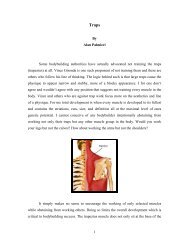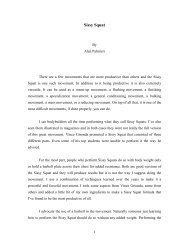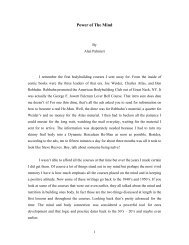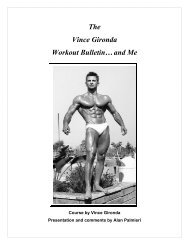Rheo H Blair and Blair Protein - Palmieribodybuilding.com
Rheo H Blair and Blair Protein - Palmieribodybuilding.com
Rheo H Blair and Blair Protein - Palmieribodybuilding.com
Create successful ePaper yourself
Turn your PDF publications into a flip-book with our unique Google optimized e-Paper software.
What was in <strong>Blair</strong>'s <strong>Protein</strong>?<br />
So what exactly was in the <strong>Rheo</strong> <strong>Blair</strong> protein formula? What made it so<br />
different?<br />
<strong>Blair</strong>'s protein was manufactured from calcium <strong>and</strong> sodium caseinate derived<br />
from nonfat dry milk, lactalbumin (egg white protein) <strong>and</strong> dried whole eggs. It also<br />
included iron phosphate <strong>and</strong> natural vanilla flavoring. The powder was originally<br />
flavored with the artificial sweetener cyclamate, until the government banned it as<br />
a carcinogen in 1969. Briefly the powder was unsweetened, save for natural milk<br />
sugar (lactose), though <strong>Blair</strong> later came out with a protein powder sweetened<br />
with fructose.<br />
A 1/4th cup serving (about the size of a single scoop provided with most protein<br />
powders) provided 102 calories, 17.5 grams of protein, 7 grams or carbohydrate<br />
<strong>and</strong> 0.6 grams of fat. There were three things that made <strong>Blair</strong>'s protein different<br />
from the other br<strong>and</strong>s on the market. First, the milk <strong>and</strong> eggs were processed by<br />
a special low-heat vacuum method that precipitated the protein in an<br />
undenatured form.<br />
The low-heat process was exclusive to <strong>Blair</strong> <strong>and</strong> meant that little nutritional value<br />
was lost in the manufacturing stage. It also made for a better tasting protein<br />
powder.<br />
Second, the ingredients were milk <strong>and</strong> egg protein. Though these later became<br />
st<strong>and</strong>ard in the industry until the advent of whey, during the 1950s <strong>and</strong> 1960s<br />
most protein powders contained a lot of soy protein which was cheap to produce,<br />
or they were made from meat derivatives.<br />
<strong>Blair</strong> originated protein powders, marketing his first, a soy-based product, in<br />
1950. He also experimented with protein extracted from meats. But his research<br />
convinced him that milk-<strong>and</strong>egg protein was the most effective way to build<br />
muscle.<br />
<strong>Blair</strong> based his conclusions primarily on biological usefulness, or what<br />
percentage of the protein can be absorbed <strong>and</strong> assimilated by the body.<br />
<strong>Blair</strong> wrote that eggs were the highest at 94 percent, followed by milk at 90<br />
percent. Gl<strong>and</strong>ular meats ranked farther down at 77 percent. He also based his<br />
findings on observation of bodybuilders he placed on various diets, including<br />
milk-egg diets <strong>and</strong> all-meat diets. His observations showed much greater growth<br />
on the milk-egg diet. (Incidently, <strong>Blair</strong> was not totally against all-meat diets. He<br />
would prescribe for his clients a meat <strong>and</strong> water diet for brief periods — one to<br />
three days ; never longer than a week — as a precontest cutting regimen. <strong>Blair</strong><br />
emphasized that bodybuilders should not expect to gain muscle with such a diet,<br />
however.)<br />
29














